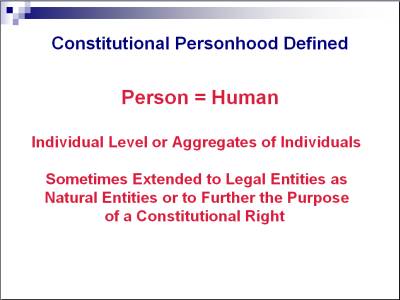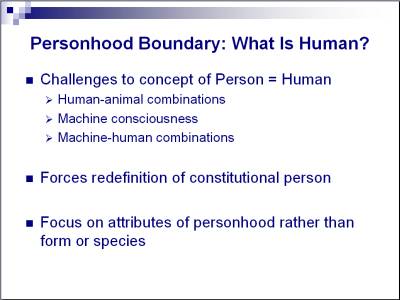Constitutional Personhood
Michael Rivard, Esq.
Page 3 of 4
After going through an extensive review of the case law, you can reach a conclusion (which should not be surprising)![]() that, under the Constitution, person equals human. It could be at the individual level or aggregates of individuals, and then in a few cases you start to see it stretching beyond that and more to the purpose of the constitutional right, but I think you can safely say that person equals human.
that, under the Constitution, person equals human. It could be at the individual level or aggregates of individuals, and then in a few cases you start to see it stretching beyond that and more to the purpose of the constitutional right, but I think you can safely say that person equals human.

Now, that approach to constitutional personhood has been fine for the last 200 plus years, but today there are new technologies emerging that may force reconsideration. The example that I used in my article was human-animal combinations. If you define human as being someone who is genetically human, and all other creatures are non-human and not constitutional persons, what happens if you take human genetic information and you steadily change it toward becoming an animal, or take an animal like a chimpanzee, which is very similar to humans, and raise up their level of intelligence so that they achieve consciousness like we have?
There are many issues with machine consciousness and whether or not it is appropriate to limit constitutional personhood under those circumstances. We have also talked about machine-human combinations.
The future technologies that are coming, the future challenges, force us to redefine what is a constitutional person. I would argue that we should be focusing on the attributes of personhood to define a constitutional person rather than the specific form or species. This raises the question, “What are those attributes?”
In summary, and I'll go through the details, this is the test for constitutional personhood that I proposed: If the average mature member of a species or a form of intelligence has the capacity for self-awareness, then all members of that species are entitled to a presumption of being a constitutional person. To exclude a member of this class from a constitutional right, or to grant someone from outside this class a constitutional right, you would have to rebut the presumption by presenting specific arguments about why someone in one group should be considered a person and why someone in another group should not be considered a person for that constitutional right.

For example, under this theory a child, as a member of the human species, would be considered a constitutional person. But this is a rebuttable presumption. Do they receive all constitutional rights? Does a newborn have all constitutional rights? No. A newborn and all children have due process rights but they don't necessarily have freedom of speech.
Where did this theory of constitutional personhood come from? It came from a review of a moral theory that underlies constitutional personhood, which had several steps. The first step is an argument that self-awareness is needed to recognize the constitutional interests of liberty and autonomy. Autonomy is independence and liberty, the ability to act on things.
1 2 3 4 next page>